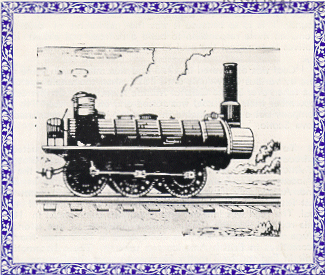
The Saga Of The SAMSON:
CANADA'S OLDEST LOCOMOTIVE

In attempting to write the saga of the Samson one must inevitably look first at the beginning of coal mining in Pictou County. This is so because it was the marketing of coal that prompted those to build a railroad and obtain locomotives to transport the coal to deep water for shipment.
Coal was discovered in 1798 and was mined with some success by various individuals until 1827 when the whole operation was taken over by the General Mining Association. On the 6th of September their first coal was raised and on December 7th the Company put a steam engine in operation, the first ever used in Nova Scotia.
To get their coal to market, the Company constructed a railroad from their works to a point a little below New Glasgow, on which they hauled the coal by horses. About this time the use of locomotives on railroads had been tried successfully in England. Accordingly it was resolved to build a railroad from the East River to the Loading Ground, for the conveyance of their coal. The road was laid out and operations commenced in 1836. The railroad was the first in British America to use standard gauge and iron rails. The line was opened in 1839 when the first locomotives in British America ran upon it. These Locomotives, built in England by Timothy Hackworth were the Samson, Hercules and Hibernia. The Samson was the first in operation and hence had the distinction of being the first locomotive in British America to run on all iron rails.
The opening of the railroad was made the occasion of general rejoicing. The two steamers, Pocahontas and Albion, with lighters attached, each carried from Pictou about 1000 persons to New Glasgow whence they were taken by train to the mines. Crowds of people on horseback and on foot were here assembled from all parts of the County. Here a procession was formed of the various trades, the Masonic lodges, the Pictou Volunteer Artillery Company, and visitors mounted, with bands and pipers at intervals, marched to New Glasgow and back again, when the Artillery Company fired a salute. A train of wagons, fitted up to carry passengers, had been attached to each engine, and being filled with the crowd, now made the trip to New Glasgow and back again, giving a new sensation to multitudes.
On their return a feast was given to the employees of the Company, for which 1,100 lbs. of beef and mutton, with corresponding quantities of other articles were provided; a dinner was given to invited guests, and the night was spent in general festivity.
This railroad, we might mention, was six miles long, and so nearly straight that the least radius of any of its curves was 1300 feet. Its width was 18 feet. The estimated quantity of excavation was 400,000 cubic yards. At the terminus was a wharf 1500 feet long and 24 feet wide. The rails were of malleable iron and the estimated cost was $160,000.
For almost 30 years the Samson performed faithfully until in 1867 it was semi-retired to work at the Foord Pit, which had recently been opened, until 1883 when it was sent to Chicago to the National Exhibition of Railway Appliances. On its return it was placed on the scrap track where it remained until 1893 when the Baltimore & Ohio Railroad placed it in their display at the Chicago Worlds Fair.
The Samson remained in Baltimore as part of a railway exhibit until 1928. At this time through the efforts of a few determined men, particularly Mr. Stewart Gibson of Halifax and Mr. Daniel Willard, President of the Baltimore & Ohio, both the Samson and the Albion (18 years younger) were returned to Nova Scotia and put on display in a train shed in Halifax.
The two locomotives remained in Halifax until 1950 when through the efforts of Hon. Michael Dwyer, then Mayor of New Glasgow, they were returned as part of New Glasgow's 75th Anniversary celebrations. It was agreed that the loan be continued indefinitely and when efforts to house the Samson on the original roadbed, now Terrace Street, failed, Mayor Dwyer arranged for a log cabin home on C. N. R. property near the Station in New Glasgow.
In 1964 the Pictou County Historical Society proposed the relocation of the Samson as a Centennial project and this proposal was accepted and a Centennial grant approved. With the grants from the Federal and Provincial Governments and the wholehearted support of the Mayor and Council of the Town of New Glasgow a fine new home has been provided for the Samson. A showcase structure of glass, steel and concrete on rising ground next to the town's Library, the new building was officially opened in August 1967.
The Samson is unique in the literal sense of the word, there is no other locomotive like it. It is 20 ft. long and 14 ft. high to the top of the stack. There is no cab for the crew and they worked exposed to the weather. The firebox was fed through the stack. It was one of the first of the 'cab ahead' type and was described as slow but of great power.
Some years after the Samson was in service an unholstered coach was ordered for first class passengers on the Stellarton, New Glasgow, Abercrombie run. The coach was also built in England by Hackworth.
The coach was not returned from Baltimore with the Samson, but Mayor Dwyer had an exact replica built and this may be seen with the Samson in their beautiful new home. Perhaps sometime in the future the original coach will be reunited with the Samson.
The
Samson Today / More Samson & Locomotive Info
Samson
Images / Samson
Route
/ About
This Project
Pictou-Antigonish Regional Library